RV Heaters Review
Review of modern RV Heating Systems for those willing to extend the RV-in season beyond the short summer time or exploring colder climate zones….
For many of us, RV-ing is associated with summer activities, so eventually one of our major concerns is cooling.
However, given the fact that these days RV-ing became the “Life Style” rather than short summer vacation adventure, the subject of heating also starts to be an important issue.
Let’s make it clear from the beginning – the right RV heating system depends on how, where and when you would like to enjoy your vacations. I guess the following assumptions are valid for majority of RV-ers:
- The RV-ing season starts in Spring and ends in Fall.
- We are not living or planning to explore Big North including Alaska (at least outside of short, warm summer time).
These greatly simplify heating solutions because the mentioned above conditions imply ambient temperatures above the freezing level. In other words the adequate heating system should be ready to alleviate the impact of chilly weather conditions (let’s say down to low 40’s). As we all know, humid cold weather will have serious impact on our level of comfort and enjoyment when on the road.


The beauty of the extended RV-in season: from the Spring till late Autumn...
Obviously if these are our goals, we do not need a 4-season RV with full thermal insulation, enclosed and heated underbelly and water tanks. To make it clear - there is nothing wrong with having good thermal insulation. In fact all-seasons RV will definitely improve not only heating but also cooling efficiency and so lower the daily cost. It can also save us from headaches when unexpected early Spring or late Fall freezing takes us (and RV’s water tanks and pipes) by surprise. However, it all comes at the higher initial cost and has to be economically justified. The bottom line is – the 4-season RVs are more expensive, so you may never recover the extra cost if not planning winter RV-ing.
Heating Systems for chilly weather conditions
- Heat Strip (add-on to the traditional AC system)
- Heat Pump (integral part of the traditional AC system)
- Conventional LPG Forced-air Heater (often RV’s standard feature)
- Portable Electric Heater
- Portable Propane Heater
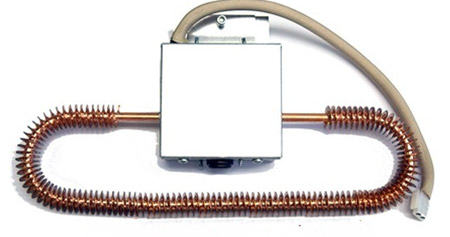
Example of the Heat Strip (Dometic)
Heat Strip.
Heat Strips are small resistance coils converting electrical energy into heat (these are probably the most familiar to us heating elements). They are placed in front of the fan blower in the AC unit so basically they have nothing to do with the AC itself. They just make use of AC ‘s fan and hot air distribution system (either ducts or distribution box).
The Heat Strips have many advantages but their help in “fighting” cold weather is very limited.
Pros:
- They are inexpensive (low initial cost)
- Can be relatively easily installed in most already existing AC systems including not only rooftop models but also under-bench ones. In other words it is a low cost and for some DIY-type of upgrade.
- They are hidden from the view and so much safer in operation. It’s a clear advantage compared to portable stand-alone heaters especially in presence of children and pets.
But the cons are also numerous:
- Most heat-strips designed for RV’s ACs have quite limited power and it’s for the reason. Traditional AC units are not designed to accommodate strong source of heat. Intense, concentrated in one spot hot-red source of heat would simply destroy (melt) components of the AC unit. When temperatures go lower, heat-strips cannot really heat the interior, they can just make it a bit friendlier. That’s why they are often called “Chill-chasers” rather the heaters and I would say it is a well-justified name.
- They run on electricity and like any AC for their operation require the grid (or generator). The 12V battery system cannot provide energy for heating (batteries will be depleted in few tens of minutes). Similarly, reasonable amount of solar panels cannot provide enough of energy (unless you take the Solar Farm on the road).
Bottom line: They are inexpensive, easy to install (provided you already have an AC in your RV), safe, but can make change only in ambient temperatures above 50’s (depending on installed power and size of your RV).
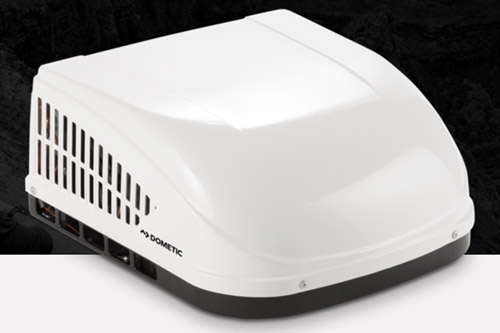
Dometic rooftop AC/Heat-Pump unit (Cooling 15k BTU/Heating 9.6k BTU)
Heat Pump
Heat pump makes an integral part of an Air Conditioner, so it cannot be considered as an “add-on” to the existing AC unit. In simple words the Heat Pump is the AC itself but working in reverse direction. The cooling operation consists in evacuating heat (and moisture) from the climate controlled area and dumping it outside in the air. The heating operation transfers the heat in the opposite direction (evacuates the heat from the outside and releases it inside of the climate-controlled zone).
It’s obvious but let’s highlight the facts:
The AC unit can more or less effectively suck the heat from the warm area and bring its temperature down (provided the area is small enough for a given AC cooling power). To do so, the AC must dump the evacuated heat into the outside air. However if the outside temperature hits triple digits (what can quickly happen when roof-mounted AC’s heat-exchange coil is exposed to summer’s sun) the heat dumping process becomes very inefficient if not impossible. As the result, the cooling process stops (in fact, the AC components may be damaged)
And the opposite is also true - the Heat Pump can increase the interior temperature in the small controlled area by dumping the heat captured outside. But there is a limitation here – when the outside temperature is low (let’s say lower than 40 degF), there is no much “heat” accumulated in the outside air and the process of “harvesting” it becomes energy inefficient. In other words the electrical energy used to reverse the direction of the heat flow (outside-in) will be higher than the amount of energy contained in the transferred heat. The bottom line is – in such conditions the traditional resistance-based electrical heater will be more efficient and less costly to operate. Note that similarly as in the cooling mode, the heat-pump may be damaged if operated in temperatures outside of the specified range.
Because the heat-pump exchanger will never get red-hot, it can be rated at higher powers compared to Heat-Strips without the risk of damaging remaining parts of the AC module. That’s why heat-pumps can act as traditional heaters, warming up RV’s interior to comfortable temperatures (well, under condition that the exterior temperature is higher than low 40’s (check specs for a specific unit).
Pros:
- AC/Heat-Pump unit is a nice integrated solution that can replace existing AC unit and fit into typical 14” x 14” roof opening.
- From the user point of view, there are no visible extra modules, so it can nicely fit into already existing cold-air distribution system (be it ducted system or central distribution box).
- Easily available heating power ranges are up to few kW (for the reference – 10k BTU/h is equivalent to about 3 kW/h. And maybe one more practical example - the Coleman HP2 AC/HP rooftop unit has the following specifications: 15k BTU cooling at the load of 16A and 12.7k BTU heating at 15.4A load. So it’s quite symmetrical performance (although when operating in specified conditions).
- When the connection to the grid is available, the LPG tanks can be fully dedicated to the primary appliances (stove, grill, hot water etc….).
Cons:
- Integrated AC/Heat-Pump modules are more expansive than just AC alone. Also, the latter cannot be “upgraded” by adding the heat-pump, it has to be replaced!
- The amount of necessary electrical energy can be provided only by grid or adequately rated gas/diesel generator. So here no difference compared to the operation of the AC unit. Basically “no grid – no heat” unless you (and neighbors) can tolerate the generator.
- You can use it only when ambient temperatures are higher than approximately 40 degF.
Notes:
Most AC units are roof-mounted so they do not take any interior storage space (compared to “under-bench” units). But there is also an extra benefit - ceiling placement is optimal from the point of view of the cooling process. The cold air is heavier than the warm one so it naturally drifts down giving place to the warm air. This natural “convection” induced air mixing process contributes to uniformity of the interior temperature.
However, the rooftop location of the heating unit is not optimal. The warm air naturally accumulates near the ceiling while colder one near the floor. That results in let’s call it “vertical” temperature gradient and “hurts” where it pains the most (feet level).
Well, there is no paradise, by the same mechanism, floor-level under bench AC units are far from optimal when it comes to cooling, but very good when it comes to heating.
Of course, the ducted systems and the blowers can change the picture by mixing air at the inconvenience of extra noise from fans and “windy” environment.
Summarizing: The AC/Heat-Pump module is an elegant, practical and good-enough heating solution when grid or generator is available. While you cannot use it in freezing temperatures, it will certainly guarantee comfortable living in chilly weather (more-or-less from Spring till Fall).
Propane Furnaces
These traditional combustion /forced-air furnaces are most common sources of heat in RVs. In many aspects they look and operate like “miniature” versions of familiar gas /forced-air residential furnaces. Thanks to the DSI device (Direct Spark Ignition) they are running fully automatically controlled by wall thermostat. Similarly as their bigger residential cousins, they need electricity for control electronics and blowers. The safety mechanism includes several sensors and propane valve that can cut-off gas supply when needed or necessary.
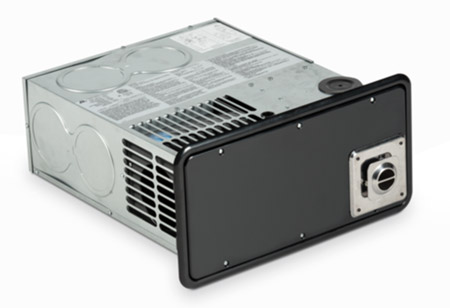
Dometic 35k BTU Propane Furnace is a compact, lightweight heater boasting a quiet operation...
The main differences compared to residential furnaces:
- For practical reasons instead of 110Vac they run on 12V battery.
- Due to limited dimensions, they do not achieve similar efficiency as modern day residential units (did you realize that highly efficient residential furnace needs bower to evacuate exhaust gases because they are so cold that the traditional convection will not work?) .
- They run on propane instead of natural gas.
Pros
- Most manufacturers include the propane furnace as a standard feature (typical heating power around 30-35k BTU).
- Gas furnaces do not need grid /generator to operate (although the 12V battery is necessary)
- Usually located at the floor level (often under the fridge) with ducts under the floor or along the sidewalls they are optimally placed for heating. They can quickly warm-up even big rigs as well as underbelly compartments, and keep water tanks and pipes above the freezing temperatures.
- Exhaust gases are evacuated through exterior vents. That improves safety and eliminates condensation. Similarly, they use exterior air (oxygen) intake so there is no need to keep open vents or window(s).
- They are very compact (can be literally hidden within the RV), relatively quiet and easy to maintain (mainly cleaning exterior vents)
- They are inexpensive (or reasonably priced if you wish)
Cons:
- They are propane hungry. Fortunately these days you can buy LPG tanks at most campgrounds and gas stations so unless you plan to get lost in wilderness, the LPG supply should not be an issue.
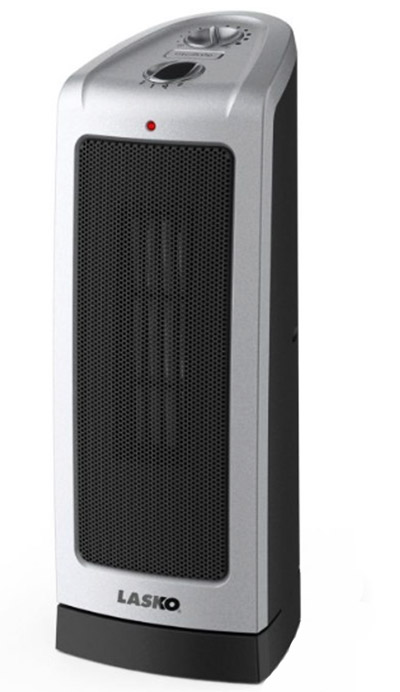
Lasko Ceramic Tower Space Heater
Portable Electric Heaters (Space Heaters)
Small, portable heaters can warm the “local” area according to the needs (be it bath before you decide to take a shower, bedroom before getting-up, living area to enjoy evening entertainment …..). They are popular solution for small RVs without a primary heating system and typically used “just in case” of chilly weather conditions (it can happen even in warm climate zones).
Often they are also used as a secondary heat source when the primary one (like Heat Strip or Heat Pump) cannot meet your needs.
Market offers variety of models with typical power range of 1kW -to- 1.5kW (for reference 1.5 kW is equivalent to approximately 5,200 BTU). Most popular types of space heaters are:
- Oil filed Radiators – They accumulate the heat and “radiate” it by natural convection. They are slow (takes time to heat the oil) and silent (no fan means quite operation). Usually they are used as “chill-chasers” in bedroom or living area.
- Ceramic Heaters – They work similar way as traditional resistance wire heaters. The main difference is that instead of red-hot metal coils, they use ceramic elements with strong “self-regulation” mechanism limiting their temperature to the range of 250 degF -to- 400 degF. The ceramic heating element is attached to aluminum fins warming surrounding air which is then blown-out by the fan. Thanks to the limited temperature of the heating element, this type of heaters is considered as very safe (basically no fire hazard). Thanks to the fan blower the process of heating the surrounding area is fast. Usually they can be set to 2 different temperatures.
Note: The Positive Thermal Coefficient (PTC) Ceramic increases its electrical resistance with temperature. The effect is much stronger than in metals causing significant increase of resistance. This in turn limits the electrical current and dissipated electrical power (so the heat).
- Infrared Radiant Heaters – They are designed to heat object in front of them (let’s call it targeted heating). They belong to the class of radiating heaters (no blower) however in contrast to oil-filled radiators they emit the heat in a sort of “focused beam”. While their radiating element is getting red (due to infrared light), they are not “hot-red” but just warm so very safe in small places. The heating effect is instant, however only in the limited area targeted by the infrared beam.
Pros:
- Portable (can heat just the area you need at a given time, so acting like “multi-zone” heating system
- Small size,
- Inexpensive (large spectrum of models available on the market)
- Quite operation (especially radiating heaters)
- Deliver dry heat (no problem with moisture)
Cons:
- They need access to grid (or generator)
- Have limited heating power
- May raise safety issues due to their exposure (especially in presence of small children or pets)
- Cannot heat RV’s underbelly
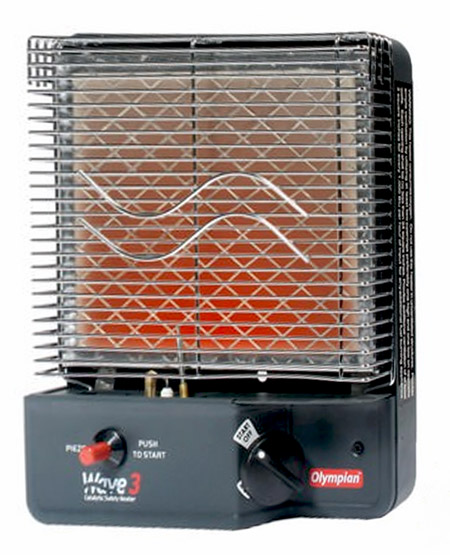
Olympian Catalytic Wave-3 Safety Heater
Portable Propane Heaters (Space Heaters)
Similarly to electrical space heaters, they are used to warm-up “local” areas inside of an RV and/or eventually outside on the patio. The main difference compared to electric heaters is the source of energy – in this case LPG. The outcome is clear – you can be warm and comfortable in out-of-grid environment. They warm the air by radiation so they are truly noiseless!
However this “freedom” of movement to the area known as out of civilization comes at the price. The propane heaters require “professional installation” (connection to the RV’s interior propane system), they use oxygen and generate “waste” gases (so they need good ventilation as well as CO and propane detectors!).
Well, many models can be fed by an “integrated” (throw-away) 1 to 2lbs LPG bottle. While it makes them fully portable and eliminates the need for professional installation, it puts an extra stress on you and on alarms system. Keep in mind that traditionally all LPG tanks are mounted outside of an RV, so the most vulnerable connection (the one used when replacing the bottle) in the case of leak is well ventilated. It’s still a dangerous situation however things are deadly serious when the leaking joint is inside of the RV. To increase the safety most propane space heaters (especially these for indoor use) are equipped with safety features like for example, Overheat Sensor, Oxygen Depletion Sensor (ODS) and Accidental Tip-Off Sensor – all of them shutting-off the gas valve (It is assumed that the CO and Propane detectors are part of RV’s mandatory features and it is your duty to make sure that they are operational).
All propane gas heaters have piezo-ignition system (time when you needed the box of matches is long gone).
The most popular types of propane heaters are:
- “Blue-Flame” - these are units with combustion area where the heat is generated by burning the propane).
- Catalytic - these units do not actually burn the propane in the traditional “violent” way (flame), they generate the heat by chemical reaction between the propane and oxygen in a platinum catalyst. They are very efficient and generate much less waste gases than blue-flame models, but they need a ventilated area! Bottom line – they still suck oxygen!
Pros:
- Good and efficient source of heat (with heating powers from few k-BTU up to 10k BTU, they can warm up larger area than electric models.
- Does not need electricity (ideal for out-of-civilization areas as well as for outdoor patios)
- Silent (no blowers - no noise)
- Portable
Cons:
- Potentially hazardous (CO, propane…)
Note: Buying the propane heater for your RV, you MUST make sure that it is the model designed for INDOOR use!.
Well, these are most popular RV heating systems that will make your trip enjoyable during chilly weather conditions with temperatures above 40's. However, if you are planing winter trips you may consider more complex and much more efficient heating systems.
See details at: --> Hydronic Heating Systems for RVs
Go back to --> RV Basics
.